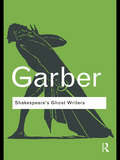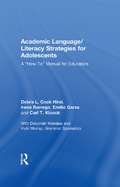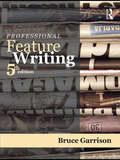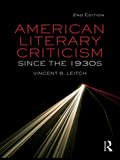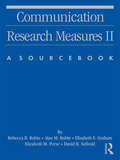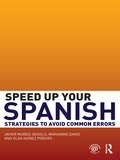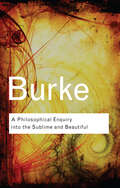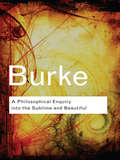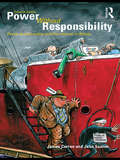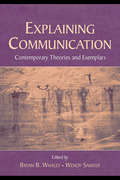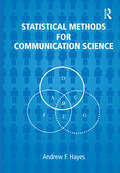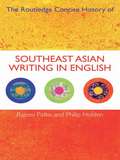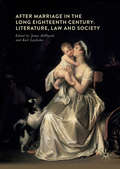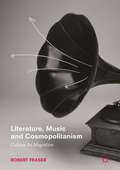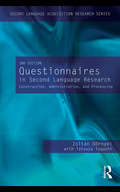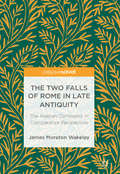- Table View
- List View
Shakespeare's Ghost Writers: Literature as Uncanny Causality
by Marjorie GarberThe plays of Shakespeare are filled with ghosts – and ghost writing. Shakespeare's Ghost Writers is an examination of the authorship controversy surrounding Shakespeare: the claim made repeatedly that the plays were ghost written. Ghosts take the form of absences, erasures, even forgeries and signatures – metaphors extended to include Shakespeare himself and his haunting of us, and in particular theorists such Derrida, Marx, Nietzsche, and Freud – the figure of Shakespeare constantly made and remade by contemporary culture. Marjorie Garber, one of the most eminent Shakespearean theorists writing today, asks what is at stake in the imputation that "Shakespeare" did not write the plays, and shows that the plays themselves both thematize and theorize that controversy. This Routledge Classics edition contains a new preface and new chapter by the author.
Academic Language/Literacy Strategies for Adolescents: A "How-To" Manual for Educators
by Debra L. Hirai Irene Borrego Emilio Garza Carl T. KloockFast-paced, practical, and innovative, this text for pre-service and in-service teachers features clear, easily accessible lessons and professional development activities to improve the delivery of academic language/literacy education across the content areas in junior/middle school and high school classrooms. Numerous hands-on tools and techniques demonstrate the effectiveness of content-area instruction for students in a wide variety of school settings, particularly English language learners, struggling readers, and other special populations of students. Based on a strong professional development model the authors have been instrumental in designing, Academic Language/Literacy Strategies for Adolescents addresses: motivation attributes of academic language vocabulary: theory and practice reading skills development grammar and writing. A wealth of charts, graphs, and lesson plans give clear examples of academic language/literacy strategies in action. The appendices – a key component of the practical applications developed in the text – include a glossary, exemplary lessons that address key content areas, and a Grammar Handbook. In this era of increased accountability, coupled with rapid demographic change and challenges to traditional curricula and pedagogical methods, educators will find this book to be a great resource.
Academic Language/Literacy Strategies for Adolescents: A "How-To" Manual for Educators
by Debra L. Hirai Irene Borrego Emilio Garza Carl T. KloockFast-paced, practical, and innovative, this text for pre-service and in-service teachers features clear, easily accessible lessons and professional development activities to improve the delivery of academic language/literacy education across the content areas in junior/middle school and high school classrooms. Numerous hands-on tools and techniques demonstrate the effectiveness of content-area instruction for students in a wide variety of school settings, particularly English language learners, struggling readers, and other special populations of students. Based on a strong professional development model the authors have been instrumental in designing, Academic Language/Literacy Strategies for Adolescents addresses: motivation attributes of academic language vocabulary: theory and practice reading skills development grammar and writing. A wealth of charts, graphs, and lesson plans give clear examples of academic language/literacy strategies in action. The appendices – a key component of the practical applications developed in the text – include a glossary, exemplary lessons that address key content areas, and a Grammar Handbook. In this era of increased accountability, coupled with rapid demographic change and challenges to traditional curricula and pedagogical methods, educators will find this book to be a great resource.
Professional Feature Writing
by Bruce GarrisonProfessional Feature Writing provides the basics of news media feature writing and establishes a solid foundation for students and writers making feature writing their career. This fifth edition offers a thorough and up-to-date look at newspaper, magazine, newsletter, and online publications, with emphasis on daily newspapers and consumer magazines. It serves as a comprehensive introduction to feature writing, emphasizing writing skills, article types, and the collegiate and professional writing life. With a wide variety of perspectives and experiences of both young and experienced writers, editors, publishers, and professors, the text is filled with practical guidance for writing a wide variety of features. Emphasizing writing values to strengthen a new writer's journalistic practices, author Bruce Garrison offers insights and expertise based on his own experience and the advice of professionals. He also includes lists of tips, observations, guidelines, sources, and story ideas, and gives a solid tour of the forms and approaches to feature writing. New for this edition are: Updated examples of feature writing, integrated throughout the text Profiles of young newspaper and magazine feature writers, highlighting their experiences and paths to success in the profession Coverage of computer-based research tools for writers, including discussion of on-line computer-based research tools with specific focus on the World Wide Web Discussion of online newspapers, magazines, newsletters, and original online publications and the role of feature writing for electronic publications. Each chapter includes excerpts and complete articles from the nation's leading publications. Building on introductory writing and reporting skills, this text is appropriate for upper-division journalism students learning feature writing and advanced writing topics. It will also serve as a valuable resource for freelance writers.
Professional Feature Writing
by Bruce GarrisonProfessional Feature Writing provides the basics of news media feature writing and establishes a solid foundation for students and writers making feature writing their career. This fifth edition offers a thorough and up-to-date look at newspaper, magazine, newsletter, and online publications, with emphasis on daily newspapers and consumer magazines. It serves as a comprehensive introduction to feature writing, emphasizing writing skills, article types, and the collegiate and professional writing life. With a wide variety of perspectives and experiences of both young and experienced writers, editors, publishers, and professors, the text is filled with practical guidance for writing a wide variety of features. Emphasizing writing values to strengthen a new writer's journalistic practices, author Bruce Garrison offers insights and expertise based on his own experience and the advice of professionals. He also includes lists of tips, observations, guidelines, sources, and story ideas, and gives a solid tour of the forms and approaches to feature writing. New for this edition are: Updated examples of feature writing, integrated throughout the text Profiles of young newspaper and magazine feature writers, highlighting their experiences and paths to success in the profession Coverage of computer-based research tools for writers, including discussion of on-line computer-based research tools with specific focus on the World Wide Web Discussion of online newspapers, magazines, newsletters, and original online publications and the role of feature writing for electronic publications. Each chapter includes excerpts and complete articles from the nation's leading publications. Building on introductory writing and reporting skills, this text is appropriate for upper-division journalism students learning feature writing and advanced writing topics. It will also serve as a valuable resource for freelance writers.
American Literary Criticism Since the 1930s
by Vincent B. LeitchAmerican Literary Criticism Since the 1930s fully updates Vincent B. Leitch’s classic book, American Literary Criticism from the 30s to the 80s following the development of the American academy right up to the present day. Updated throughout and with a brand new chapter, this second edition: provides a critical history of American literary theory and practice, discussing the impact of major schools and movements examines the social and cultural background to literary research, considering the role of key theories and practices provides profiles of major figures and influential texts, outlining the connections among theorists presents a new chapter on developments since the 1980s, including discussions of feminist, queer, postcolonial and ethnic criticism. Comprehensive and engaging, this book offers a crucial overview of the development of literary studies in American universities, and a springboard to further research for all those interested in the development and study of Literature.
American Literary Criticism Since the 1930s
by Vincent B. LeitchAmerican Literary Criticism Since the 1930s fully updates Vincent B. Leitch’s classic book, American Literary Criticism from the 30s to the 80s following the development of the American academy right up to the present day. Updated throughout and with a brand new chapter, this second edition: provides a critical history of American literary theory and practice, discussing the impact of major schools and movements examines the social and cultural background to literary research, considering the role of key theories and practices provides profiles of major figures and influential texts, outlining the connections among theorists presents a new chapter on developments since the 1980s, including discussions of feminist, queer, postcolonial and ethnic criticism. Comprehensive and engaging, this book offers a crucial overview of the development of literary studies in American universities, and a springboard to further research for all those interested in the development and study of Literature.
Communication Research Measures II: A Sourcebook (Routledge Communication Series)
by Elizabeth Graham Rebecca B. Rubin Alan M Rubin Elizabeth M. Perse David SeiboldExpanding and building on the measures included in the original 1994 volume, Communication Research Measures II: A Sourcebook provides new measures in mass, interpersonal, instructional, and group/organizational communication areas, and highlights work in newer subdisciplines in communication, including intercultural, family, and health. It also includes measures from outside the communication discipline that have been employed in communication research. The measures profiled here are "the best of the best" from the early 1990s through today. They are models for future scale development as well as tools for the trade, and they constitute the main tools that researchers can use for self-administered measurement of people's attitudes, conceptions of themselves, and perceptions of others. The focus is on up-to-date measures and the most recent scales and indexes used to assess communication variables. Providing suggestions for measurement of concepts of interest to researchers; inspiring students to consider research directions not considered previously; and supplying models for scale developers to follow in terms of the work necessary to produce a valid and reliable measurement instrument in the discipline, the authors of this key resource have developed a significant contribution toward improving measurement and providing measures for better science.
Speed Up Your Spanish: Strategies to Avoid Common Errors
by Javier Muñoz-Basols Marianne David Olga Núñez Piñeiro‘Excellent book. The chapters put together and systematise a lot of material that is often taught in an anecdotal or haphazard sort of way, if at all. Students will learn a great deal from the book and have their confidence in using Spanish considerably boosted as a result.’ – Jonathan Thacker, Merton College, University of Oxford, UK ‘An invaluable, highly original and methodically sound approach to correcting and eliminating common, yet difficult-to-eliminate errors.’ – Manuel Delgado, Bucknell University, USA ‘The user-friendly format and page layout makes Speed Up Your Spanish a highly practical reference source for students and teachers.’– Ma Victoria García Serrano, University of Pennsylvania, USA False friends, idiomatic expressions, gender and capitalization are just some of the areas that cause confusion for students of Spanish. Learning how to avoid the common errors that arise repeatedly in these areas is an essential step for successful language learning. Speed Up Your Spanish is a unique and innovative resource that identifies and explains such errors, thereby enabling students of Spanish to learn from their mistakes while enhancing their understanding of the Spanish language. Each of the nine chapters focuses on a grammatical category where English speakers typically make mistakes in Spanish. Each chapter is divided into sections that classify the concepts and errors into subcategories. Full explanations are provided throughout with clear, comprehensive examples and exercises to help the learner gain an in-depth understanding of Spanish grammar and usage. Key features: carefully selected grammar topics and examples based on the most commonly made errors exercises throughout to reinforce learning shortcuts and mnemonic devices providing vital learning strategies a Companion Website available at www.speedupyourspanish.com providing supplementary exercises as well as audio files. Suitable both for classroom use or self-study, Speed Up Your Spanish is the ideal resource for all intermediate learners of Spanish wishing to refine their language skills. Javier Muñoz-Basols is an Instructor in Spanish at the University of Oxford. Marianne David teaches Spanish at the Trinity School in New York. Olga Núñez Piñeiro is Senior Lecturer in Spanish at the University of Westminster.
Speed Up Your Spanish: Strategies to Avoid Common Errors
by Javier Muñoz-Basols Marianne David Olga Núñez Piñeiro‘Excellent book. The chapters put together and systematise a lot of material that is often taught in an anecdotal or haphazard sort of way, if at all. Students will learn a great deal from the book and have their confidence in using Spanish considerably boosted as a result.’ – Jonathan Thacker, Merton College, University of Oxford, UK ‘An invaluable, highly original and methodically sound approach to correcting and eliminating common, yet difficult-to-eliminate errors.’ – Manuel Delgado, Bucknell University, USA ‘The user-friendly format and page layout makes Speed Up Your Spanish a highly practical reference source for students and teachers.’– Ma Victoria García Serrano, University of Pennsylvania, USA False friends, idiomatic expressions, gender and capitalization are just some of the areas that cause confusion for students of Spanish. Learning how to avoid the common errors that arise repeatedly in these areas is an essential step for successful language learning. Speed Up Your Spanish is a unique and innovative resource that identifies and explains such errors, thereby enabling students of Spanish to learn from their mistakes while enhancing their understanding of the Spanish language. Each of the nine chapters focuses on a grammatical category where English speakers typically make mistakes in Spanish. Each chapter is divided into sections that classify the concepts and errors into subcategories. Full explanations are provided throughout with clear, comprehensive examples and exercises to help the learner gain an in-depth understanding of Spanish grammar and usage. Key features: carefully selected grammar topics and examples based on the most commonly made errors exercises throughout to reinforce learning shortcuts and mnemonic devices providing vital learning strategies a Companion Website available at www.speedupyourspanish.com providing supplementary exercises as well as audio files. Suitable both for classroom use or self-study, Speed Up Your Spanish is the ideal resource for all intermediate learners of Spanish wishing to refine their language skills. Javier Muñoz-Basols is an Instructor in Spanish at the University of Oxford. Marianne David teaches Spanish at the Trinity School in New York. Olga Núñez Piñeiro is Senior Lecturer in Spanish at the University of Westminster.
A Philosophical Enquiry Into the Sublime and Beautiful
by Edmund BurkeEdited with an introduction and notes by James T. Boulton. 'One of the greatest essays ever written on art.'– The Guardian Edmund Burke’s A Philosophical Enquiry into the Origin of our Ideas of the Sublime and Beautiful is one of the most important works of aesthetics ever published. Whilst many writers have taken up their pen to write of "the beautiful", Burke’s subject here was the quality he uniquely distinguished as "the sublime"—an all-consuming force beyond beauty that compelled terror as much as rapture in all who beheld it. It was an analysis that would go on to inspire some of the leading thinkers of the age, including Immanuel Kant and Denis Diderot. The Routledge Classics edition presents the authoritative text of the first critical edition of Burke’s essay ever published, including a substantial critical and historical commentary. Edmund Burke (1729–1797). A politician, philosopher and orator, Burke lived during a turbulent time in world history, which saw revolutions in America and France that inspired his most famous work, Reflections on the Revolution in France.
A Philosophical Enquiry Into the Sublime and Beautiful
by Edmund BurkeEdited with an introduction and notes by James T. Boulton. 'One of the greatest essays ever written on art.'– The Guardian Edmund Burke’s A Philosophical Enquiry into the Origin of our Ideas of the Sublime and Beautiful is one of the most important works of aesthetics ever published. Whilst many writers have taken up their pen to write of "the beautiful", Burke’s subject here was the quality he uniquely distinguished as "the sublime"—an all-consuming force beyond beauty that compelled terror as much as rapture in all who beheld it. It was an analysis that would go on to inspire some of the leading thinkers of the age, including Immanuel Kant and Denis Diderot. The Routledge Classics edition presents the authoritative text of the first critical edition of Burke’s essay ever published, including a substantial critical and historical commentary. Edmund Burke (1729–1797). A politician, philosopher and orator, Burke lived during a turbulent time in world history, which saw revolutions in America and France that inspired his most famous work, Reflections on the Revolution in France.
Power Without Responsibility: Press, Broadcasting and the Internet in Britain
by James Curran Jean SeatonPower Without Responsibility is a classic introduction to the history, sociology, theory and politics of the media in Britain. Hailed by the Times Higher as the 'seminal media text', and translated into Arabic, Chinese and other foreign languages, it is an essential guide for media students and critical media consumers alike. The new edition has been substantially revised to bring it right up-to-date with developments in the media industry, new media technologies and changes in the political and academic debates surrounding the media. In this new edition, the authors consider: the impact of the internet the failure of interactive TV media and Britishness new media and global understanding journalism in crisis BBC and broadcasting at the beginning of the twenty-first century. Assessing the media at a time of profound change, the authors set out the democratic choices for media reform.
Explaining Communication: Contemporary Theories and Exemplars
by Bryan B. Whaley Wendy SamterOffering a direct sightline into communication theory, Explaining Communication provides in-depth discussions of communication theories by some of the foremost scholars working in communication today. With contributions from the original theorists and scholars known for their work in specific theoretical perspectives, this distinctive text breaks new ground in giving these scholars the opportunity to address students firsthand, speaking directly to the coming generations of communication scholars. Covering a wide range of interpersonal communication theories, the scope of this exceptional volume includes:*the nature of theory and fundamental concepts in interpersonal communication;*theories accounting for individual differences in message production; explanations of human communication from dyadic, relational, and/or cultural levels; and*a history of communication theory. Chapter authors offer their own views of the core ideas and findings of specific theoretical perspectives, discussing the phenomena those perspectives are best positioned to explain, how the theories fit into the field, and where future research efforts are best placed. While by no means comprehensive, Explaining Communication includes those theories that rank among those most often used in today’s work, that have generated a substantial body of knowledge over time, and that have not been articulated in detail in other publications. With detailed explorations and first-hand discussions of major communication theories, this volume is essential for students in communication studies, interpersonal communication, and advanced theory courses, as well as for scholars needing a thorough reference to some of the most salient theories in communication today.
Explaining Communication: Contemporary Theories and Exemplars
by Bryan B. Whaley Wendy SamterOffering a direct sightline into communication theory, Explaining Communication provides in-depth discussions of communication theories by some of the foremost scholars working in communication today. With contributions from the original theorists and scholars known for their work in specific theoretical perspectives, this distinctive text breaks new ground in giving these scholars the opportunity to address students firsthand, speaking directly to the coming generations of communication scholars. Covering a wide range of interpersonal communication theories, the scope of this exceptional volume includes:*the nature of theory and fundamental concepts in interpersonal communication;*theories accounting for individual differences in message production; explanations of human communication from dyadic, relational, and/or cultural levels; and*a history of communication theory. Chapter authors offer their own views of the core ideas and findings of specific theoretical perspectives, discussing the phenomena those perspectives are best positioned to explain, how the theories fit into the field, and where future research efforts are best placed. While by no means comprehensive, Explaining Communication includes those theories that rank among those most often used in today’s work, that have generated a substantial body of knowledge over time, and that have not been articulated in detail in other publications. With detailed explorations and first-hand discussions of major communication theories, this volume is essential for students in communication studies, interpersonal communication, and advanced theory courses, as well as for scholars needing a thorough reference to some of the most salient theories in communication today.
Statistical Methods for Communication Science (Routledge Communication Series)
by Andrew F. HayesStatistical Methods for Communication Science is the only statistical methods volume currently available that focuses exclusively on statistics in communication research. Writing in a straightforward, personal style, author Andrew F. Hayes offers this accessible and thorough introduction to statistical methods, starting with the fundamentals of measurement and moving on to discuss such key topics as sampling procedures, probability, reliability, hypothesis testing, simple correlation and regression, and analyses of variance and covariance. Hayes takes readers through each topic with clear explanations and illustrations. He provides a multitude of examples, all set in the context of communication research, thus engaging readers directly and helping them to see the relevance and importance of statistics to the field of communication.Highlights of this text include:*thorough and balanced coverage of topics;*integration of classical methods with modern "resampling" approaches to inference;*consideration of practical, "real world" issues;*numerous examples and applications, all drawn from communication research;*up-to-date information, with examples justifying use of various techniques; and*a CD with macros, data sets, figures, and additional materials.This unique book can be used as a stand-alone classroom text, a supplement to traditional research methods texts, or a useful reference manual. It will be invaluable to students, faculty, researchers, and practitioners in communication, and it will serve to advance the understanding and use of statistical methods throughout the discipline.
The Routledge Concise History of Southeast Asian Writing in English
by Rajeev S. Patke Philip HoldenThe Routledge Concise History of Southeast Asian Writing in English traces the development of literature in the region within its historical and cultural contexts. This volume explores creative writing in English across different genres and media, establishing connections from the colonial activity of the early modern period through to contemporary writing across Southeast Asia, focusing especially on the Philippines, Malaysia, Singapore and Hong Kong. In this critical guide, Rajeev S. Patke and Philip Holden: interweave text and context through the history of creative writing in the region examine language use and variation, making use of illuminating examples from speech, poetry and fictional prose trace the impact of historical, political and cultural events engage with current debates on national consciousness, globalization, modernity and postmodernism provide useful features including a glossary, further reading section and chapter summaries. Direct and clearly written, this Concise History guides readers through key topics while presenting a unique, original synthesis of history and practice in Southeast Asian writing in English. It is the ideal starting point for students and all those seeking a better understanding of Southeast Asian literatures and cultures.
The Routledge Concise History of Southeast Asian Writing in English
by Rajeev S. Patke Philip HoldenThe Routledge Concise History of Southeast Asian Writing in English traces the development of literature in the region within its historical and cultural contexts. This volume explores creative writing in English across different genres and media, establishing connections from the colonial activity of the early modern period through to contemporary writing across Southeast Asia, focusing especially on the Philippines, Malaysia, Singapore and Hong Kong. In this critical guide, Rajeev S. Patke and Philip Holden: interweave text and context through the history of creative writing in the region examine language use and variation, making use of illuminating examples from speech, poetry and fictional prose trace the impact of historical, political and cultural events engage with current debates on national consciousness, globalization, modernity and postmodernism provide useful features including a glossary, further reading section and chapter summaries. Direct and clearly written, this Concise History guides readers through key topics while presenting a unique, original synthesis of history and practice in Southeast Asian writing in English. It is the ideal starting point for students and all those seeking a better understanding of Southeast Asian literatures and cultures.
After Marriage in the Long Eighteenth Century: Literature, Law and Society
by Jenny DiPlacidi Karl LeydeckerThis book examines the intersections between the ways that marriage was represented in eighteenth-century writing and art, experienced in society, and regulated by law. The interdisciplinary and comparative essays explore the marital experience beyond the ‘matrimonial barrier’ to encompass representations of married life including issues of spousal abuse, parenting, incest, infidelity and the period after the end of marriage, to include annulment, widowhood and divorce. The chapters range from these focuses on legal and social histories of marriage to treatments of marriage in eighteenth-century periodicals, to depictions of married couples and families in eighteenth-century art, to parallels in French literature and diaries, to representations of violence and marriage in Gothic novels, and to surveys of same-sex partnerships. The volume is aimed towards students and scholars working in the long eighteenth century, gender studies, women’s writing, publishing history, and art and legal historians.
After Marriage in the Long Eighteenth Century: Literature, Law and Society
by Jenny DiPlacidi Karl LeydeckerThis book examines the intersections between the ways that marriage was represented in eighteenth-century writing and art, experienced in society, and regulated by law. The interdisciplinary and comparative essays explore the marital experience beyond the ‘matrimonial barrier’ to encompass representations of married life including issues of spousal abuse, parenting, incest, infidelity and the period after the end of marriage, to include annulment, widowhood and divorce. The chapters range from these focuses on legal and social histories of marriage to treatments of marriage in eighteenth-century periodicals, to depictions of married couples and families in eighteenth-century art, to parallels in French literature and diaries, to representations of violence and marriage in Gothic novels, and to surveys of same-sex partnerships. The volume is aimed towards students and scholars working in the long eighteenth century, gender studies, women’s writing, publishing history, and art and legal historians.
Literature, Music and Cosmopolitanism: Culture as Migration
by Robert FraserThis book focuses on the twin arts of literature and music, supporting the notion that cosmopolitanism is the natural condition of all the arts, and that all culture - without exception - is migrant culture. It draws on examples ranging from the first to the twenty-first centuries AD, on locations as remote as Alexandria and Australia, on writers as different as Virgil and V.S.Naipaul, Arnold and Achebe, and on musicians as diverse as Bach and Bartok, Purcell and Steve Reich. Across thirteen chapters, the study explores the interpenetration of all forms of human expression, the fallacy of 'national' traditions and limiting conceptions of regional character. The result is an exploration of artistic and intellectual endeavour that is particularly welcome in the current political climate, encouraging us to view history in ways informed by our contemporary demographic and cultural concerns. Taken either as a series of interrelated case studies, or else as an evolving and sequential argument, this book is vital reading for scholars of music, literature, and cultural and social history.
Questionnaires in Second Language Research: Construction, Administration, and Processing
by Zoltán Dörnyei Tatsuya TaguchiQuestionnaires in Second Language Research: Construction, Administration, and Processing is the first guide in the second language field devoted to the question of how to produce and use questionnaires as reliable and valid research instruments. It offers a thorough overview of the theory of questionnaire design, administration, and processing, made accessible by concrete, real-life second language research applications. This Second Edition features a new chapter on how an actual scientific instrument was developed using the theoretical guidelines in the book, and new sections on translating questionnaires and collecting survey data on the Internet. Researchers and students in second language studies, applied linguistics, and TESOL programs will find this book invaluable, and it can also be used as a textbook for courses in quantitative research methodology and survey research in linguistics, psychology, and education departments.
Literature, Music and Cosmopolitanism: Culture as Migration
by Robert FraserThis book focuses on the twin arts of literature and music, supporting the notion that cosmopolitanism is the natural condition of all the arts, and that all culture - without exception - is migrant culture. It draws on examples ranging from the first to the twenty-first centuries AD, on locations as remote as Alexandria and Australia, on writers as different as Virgil and V.S.Naipaul, Arnold and Achebe, and on musicians as diverse as Bach and Bartok, Purcell and Steve Reich. Across thirteen chapters, the study explores the interpenetration of all forms of human expression, the fallacy of 'national' traditions and limiting conceptions of regional character. The result is an exploration of artistic and intellectual endeavour that is particularly welcome in the current political climate, encouraging us to view history in ways informed by our contemporary demographic and cultural concerns. Taken either as a series of interrelated case studies, or else as an evolving and sequential argument, this book is vital reading for scholars of music, literature, and cultural and social history.
The Two Falls of Rome in Late Antiquity: The Arabian Conquests in Comparative Perspective
by James Moreton WakeleyThis book offers a radical perspective on what are conventionally called the Islamic Conquests of the seventh century. Placing these earthshattering events firmly in the context of Late Antiquity, it argues that many of the men remembered as the fanatical agents of Muḥammad probably did not know who the prophet was and had, in fact, previously fought for Rome or Persia. The book applies to the study of the collapse of the Roman Near East techniques taken from the historiography of the fall of the Roman West. Through a comparative analysis of medieval Arabic and European sources combined with insights from frontier studies, it argues that the two falls of Rome involved processes far more similar than traditionally thought. It presents a fresh approach to the century that witnessed the end of the ancient world, appealing to students of Roman and medieval history, Islamic Studies, and advanced scholars alike.
The Two Falls of Rome in Late Antiquity: The Arabian Conquests in Comparative Perspective
by James Moreton WakeleyThis book offers a radical perspective on what are conventionally called the Islamic Conquests of the seventh century. Placing these earthshattering events firmly in the context of Late Antiquity, it argues that many of the men remembered as the fanatical agents of Muḥammad probably did not know who the prophet was and had, in fact, previously fought for Rome or Persia. The book applies to the study of the collapse of the Roman Near East techniques taken from the historiography of the fall of the Roman West. Through a comparative analysis of medieval Arabic and European sources combined with insights from frontier studies, it argues that the two falls of Rome involved processes far more similar than traditionally thought. It presents a fresh approach to the century that witnessed the end of the ancient world, appealing to students of Roman and medieval history, Islamic Studies, and advanced scholars alike.
